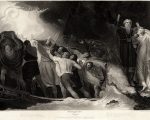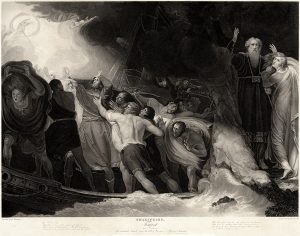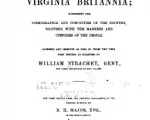
 On this day in history, 4th April 1572, William Strachey, writer and historian of Virginia, was born. When I was researching for my book On This Day in Tudor History, I noticed that William Shakespeare was said to have used Strachey's account of the 1609 shipwreck of the Sea Venture as a source for his play “The Tempest”. This made me want to know more about Strachey and the shipwreck, plus his account of it.
On this day in history, 4th April 1572, William Strachey, writer and historian of Virginia, was born. When I was researching for my book On This Day in Tudor History, I noticed that William Shakespeare was said to have used Strachey's account of the 1609 shipwreck of the Sea Venture as a source for his play “The Tempest”. This made me want to know more about Strachey and the shipwreck, plus his account of it.
William Strachey was born in Saffron Walden, in Essex, on 4th April 1572, and was the son of William and Mary (née Cooke) Strachey. William was educated at Emmanuel College, Cambridge, before he joined Gray's Inn in London. Strachey's biographer, Betty Wood, writes of how his interest in literature, brought him into contact with men like William Shakespeare, Ben Jonson, and Thomas Campion. His sonnet "Upon Sejanus" was published in Ben Jonson's play "Sejanus His Fall" in 1605. Strachey was also a shareholder in the Children of the Revels, a troupe of boy-actors.
In 1602, he inherited his father's estate and lived off that until his money dwindled in 1605. In 1606, he obtained the position of secretary to Thomas Glover, the English ambassador to Constantinople, but he returned to England in 1607 after being dismissed. In 1609, he purchased two shares in the Virginia Company of London and in June 1609, he set sail for Virginia on the Sea Venture, which was captained by Christopher Newport. Unfortunately, a "terrible storme", i.e., a hurricane, caused the ship to run aground on an uninhabited island in the Bermudas, which Strachey described as "Devils illands" that were to be "feared and avoyded … above any other place in the world". Strachey and the ship's crew were stuck there for nearly a year. They were eventually able to construct two boats, Patience and Deliverance, which allowed them to continue their journey. Strachey wrote an account of the shipwreck and what Betty Wood describes as "the precarious state of the settlement at Jamestown" in a letter dated 15th July 1610, but it was suppressed by the Virginia Colony. It was eventually published in 1625 as "A true reportory of the wracke, and redemption of Sir Thomas Gates Knight; vpon, and from the Ilands of the Bermudas: his coming to Virginia, and the estate of that Colonie then, and after, vnder the gouernment of the Lord La Warre, Iuly 15. 1610" in Purchas his Pilgrimes, four-volume collection of travel narratives by Samuel Purchas.
Strachey served as secretary of the Virginia Company and was asked by the company to write an official account of the colony, which he did, on his return to London in 1611. However, his "The Historie of Travaile Into Virginia Britannia", was critical of the colony, like his earlier account, and so was not published in his lifetime.
Strachey also compiled a glossary of words used by the Powhatan people. You can read this at https://repository.si.edu/bitstream/handle/10088/22095/bae_bulletin_157_1955_46_189-202.pdf.
Strachey was married twice: to Frances Forster, and to a woman named Dorothy. He had two sons with Frances: William and Edmund.
Strachey died in June 1621 and was laid to rest in St Giles' Church, Camberwell in Surrey, UK.
Here are links to Strachey's accounts of Virginia so that you can read them for yourself:
- The Historie of Travaile Into Virginia Britannia - https://archive.org/details/historietravail00majogoog/page/n9
- A true reportory of the wracke, and redemption of Sir Thomas Gates Knight; vpon, and from the Ilands of the Bermudas: his coming to Virginia, and the estate of that Colonie then, and after, vnder the gouernment of the Lord La Warre, Iuly 15. 1610 - http://www.virtualjamestown.org/TR%20modern.doc
Sources
- Strachey's 'A true reportory of the wreck' in Bermuda - https://www.bl.uk/collection-items/stracheys-a-true-reportory-of-the-wreck-in-bermuda
- Wood, B. (2004, September 23). Strachey, William (1572–1621), historian of Virginia. Oxford Dictionary of National Biography. Ed.
- William Strachey, Wikipedia - https://en.wikipedia.org/wiki/William_Strachey
- True Reportory, Wikipedia - https://en.wikipedia.org/wiki/True_Reportory.
Picture: The shipwreck in Act I, Scene 1, of The Tempest, in a 1797 engraving by Benjamin Smith after a painting by George Romney.

